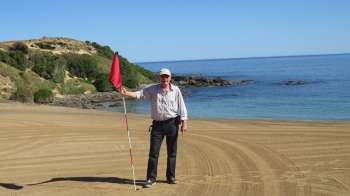Battle Royal - Augusta National versus Royal Melbourne
Last month in Australian Golf Digest we recognised the greatness of Royal Melbourne West, by yet again declaring it Australia’s best golf course. This month the attention of the golfing world turns to another classic layout from the 1930s, Augusta National, as it prepares to host the 78th edition of its Masters Tournament.
Although two different courses in two different countries, Augusta National and Royal Melbourne share some obvious common links. Both regularly host championship events and sit atop national golf course ranking lists. Both were also designed, at least initially, by the great Dr. Alister MacKenzie. It begs the question; which one is better?
While the question itself may seem simple, the answer is quite complex. It depends, for example, on how one defines ‘better’ or ‘best’. As a tournament venue and theatre for great drama, Augusta National is without peer. As a pure golfing test, however, Royal Melbourne West might just have its measure. Not because it’s harder, longer or more spectacular, but because it is a more egalitarian challenge that is both accessible and playable to a far wider range of golfers and golfing abilities.
Ordinarily, suggesting that Augusta National was anything short of perfection would bring a stinging rebuke from its millions of fans. For many Augusta is golf’s Sistine Chapel, the most sacred patch of turf we have in our game. From the foundations of the club and the legend of the Masters Tournament, to an architectural lineage that includes names like MacKenzie, Maxwell and Bobby and Robert Trent Jones, the place has an undeniable allure and seems to ooze greatness.
While you could make the case that Augusta’s holes were more significant than those at Royal Melbourne, arguing they were better might be more difficult. They certainly aren’t as faithful to the design ideals of Alister MacKenzie. Significant structural and cosmetic change has taken place on virtually all holes at some point in their history. The 7th, 10th and 16th greens, for example, aren’t even where MacKenzie built them while each of the 1st, 2nd, 5th, 6th, 9th and 17th greens is radically different from what he had designed. About the only holes that still resemble the MacKenzie plan are the 3rd, 11th and 13th, although in each case the bunker shapes and green outlines have changed.
Across Augusta holes are far longer, tighter and more difficult than the good doctor would have ever intended. Regardless of the precise changes, or the reasons they were implemented, the suggestion could be made that a course in a constant state of alteration must have fundamental flaws. Such flaws would be amplified by the fact the club hosts a major championship on an annual basis, and values the protection of its par. Can such a course, therefore, be held up as ideal if millions of dollars need to be spent each decade keeping it up-to-speed and relevant?
Like Augusta National, green speeds at Royal Melbourne have increased dramatically over the decades and the club has invested richly in irrigation and turf technology to ensure pure putting surfaces. By maintaining firm and fast surfaces the club is able to defend the strategic principles enshrined in the MacKenzie design. Angles and accuracy counts, and playing approach shots from out-of-position is the first step on the path to a higher score. If Royal Melbourne had more land at its disposal they would almost certainly have added length to the West Course, but it’s unlikely they would have made significant design alterations. The holes simply don’t need them.
By contrast, the holes we all grew up watching at Augusta National are famed for both their character and their difficulty and sometimes you need to sacrifice one in order to enhance the other. That’s what has happened across many parts of the layout, particularly on the front nine. It’s why an objective analysis of the two courses is so interesting, because the front side at Royal Melbourne is so clearly superior to Augusta’s but on the back nine the roles are reversed.
In order to determine which course is superior we decided to pit them head-to-head against each other, and see whether a matchplay duel across all 18 holes could give us a winner. Like a barnstorming Sunday finish at the Masters, it came right down to the wire.
The Showdown - Augusta National vs Royal Melbourne (West)
Hole 1 – Halved (Match Square)
Neither opening hole is among the most distinguished on the course, but each offers chances for both birdie and bogey. The fairway at Augusta is uncomfortably narrow but the green site is at least the equal of Royal Melbourne.
Hole 2 – Halved (Match Square)
Two classic par fives, two fascinating par five greens. Were it a little more interesting off the tee, the 2nd at Royal Melbourne would win this handsomely.
Hole 3 – Royal Melbourne (RM 1 up)
Another very close call, but the brilliant front-to-back green site at Royal Melbourne nudges it ahead of Augusta National’s one and only sub 320-metre par four.
Hole 4 – Royal Melbourne (RM 2 upz)
Hard to compare short holes to long ones, but the 4th at Royal Melbourne West is a great par five, while the par three 4th at Augusta is merely a pass. The shallow green is a nasty target for the world’s best professionals and absolutely brutal on the average amateur. Interestingly, this is one of the few holes that look even harder on the original MacKenzie plan.
Hole 5 – Royal Melbourne (RM 3 up)
One of the better par fours on the front nine, the 5th at Augusta features a fascinating target dominated by a broad ridge across its middle. As good as it is, there are few holes anywhere that can match the mighty 5th at RM West.
Hole 6 – Royal Melbourne (RM 4 up)
Another easy win for Royal Melbourne, and a brilliant dogleg par four that is far too good for a steeply dropping par three whose only decent pin positions are almost unplayable for the non-Professional.
Hole 7 – Royal Melbourne (RM 5 up)
To do well against Augusta National you need to build a strong lead over the front nine and try to hang on through the back. Royal’s delicious short 7th extends its lead out to 5 holes, by easily accounting for Augusta’s awkwardly stretched and narrowed par four. One of the few dull holes at Augusta, the 7th merely tests your ability to strike a pinpoint tee shot through trees followed by a precision approach that hits and stops.
Hole 8 – Augusta National (RM 4 up)
Both holes are under-rated, though different, and one suspects that had MacKenzie’s original 8thgreen survived the Clifford Roberts years it would have won this battle more comfortably. As it stands, the unique green setting and relatively broad playing corridor nudge it slightly ahead of Royal’s deceptive mid-length four.
Hole 9 – Augusta National (RM 3 up)
Similar par fours that fall and rise into very treacherous targets, the 9th at Augusta wins for a more demanding tee shot and a more attractive green site. MacKenzie’s original horseshoe green here looked amazing.
Hole 10 – Halved (RM 3 up)
Impossible to separate, these two wonderful par fours are different but dominated by both a striking fairway bunker and a sharply angled putting green. To have voted against either would have been an injustice.
Hole 11 – Augusta National (RM 2 up)
The comeback continues with Augusta’s iconic long dogleg right par four edging out Royal’s under-rated long dogleg left par four. As good as the 11th at Royal Melbourne is, few would argue it was superior to White Dogwood.
Hole 12 – Augusta National (RM 1 up)
As difficult as it can be to judge par threes against par fives, there is no question that Augusta’s brilliant 12th comfortably wins this battle.
Hole 13 – Augusta National (Match Square)
Another one-sided victory to Augusta National, and the comeback is complete with our match now back to all-square. As great as some of these other holes are, the par five 13th at Augusta probably tops them all.
Hole 14 – Augusta National (AN 1 up)
MacKenzie’s classic two-shot green at Augusta beats his classic two-shot green on the Sandbelt, so the win here goes overseas. Both holes are somewhat under-appreciated in the context of what else is available but fun and charming nonetheless.
Hole 15 – Augusta National (AN 2 up)
Not even Dr. MacKenzie was a fan of the 15th at Royal Melbourne, a hole that despite improvements since opening cannot compete with the drama and excitement of that famous five over in Georgia. Augusta’s 15th has changed enormously since MacKenzie’s original concept, mostly for the better.
Hole 16 – Royal Melbourne (AN 1 up)
On the surface awarding the 16th hole to Royal Melbourne may appear a controversial decision, but the reality is that we are pitting a very good hole here against a great one. Royal’s is one of those rare long par threes that test both execution and playing strategy, while Trent Jones’ shot across the lake is essentially about judging how your ball will feed off a slope. Awesome to watch on television and fun to attempt in the flesh, Augusta 16 is memorable but not quite in the class of the better par threes here.
Hole 17 – Royal Melbourne (Match Square)
Hard to argue that any straight-away par four to an anorexic fairway is a match for the wonderful 17th on Royal Melbourne West. Augusta’s has a decent, if somewhat tricked-up, green site, but there are too many trees for comfortable play. Plus 17 West is sublime.
Hole 18 – Royal Melbourne (RM WINS 1 UP)
All square standing on the final tee and we are faced with two intimidating tee shots, one through a narrow chute of trees and rising and the other across a bunkered ridge to a fairway falling away from the green. Removing aura, history and the magic of a manic Masters finish, the winner here has to be the West Course at Royal Melbourne. It’s green site and bunkering are too good, and the 18th at Augusta too steep for there to be any other outcome. MacKenzie’s original hole at Augusta was much wider and more strategic, but it’s become borderline impossible for the average golfer and would barely rate a mention as a fan favourite were it not for the drama of a Masters finale.
Darius Oliver, Architecture Editor Australian Golf Digest
Do you agree, or is Augusta National superior to Royal Melbourne West? Send comments to darius@planetgolf.com.au
Back to NewsMore News
Who Really Designed Cape Wickham Links?
AGD ranks Cape Wickham #1 in Australia & interviews Duncan Andrews to get full story on course design
Landmark professional golf tournament coming to Auckland
Pro golf will make a major return to NZ's largest city next March with event hosted by Royal Auckland & Grange
Grace Kim confirmed for 2026 women's Australian Open
Australian star will headline the Women’s Open when it returns to Kooyonga Golf Course in March
AGF releases 2024/25 Impact Report, highlighting life-changing opportunities for young Australians
The Australian Golf Foundation Report reveals a year of progress in making golf more accessible, inclusive, and life-changing for young people



